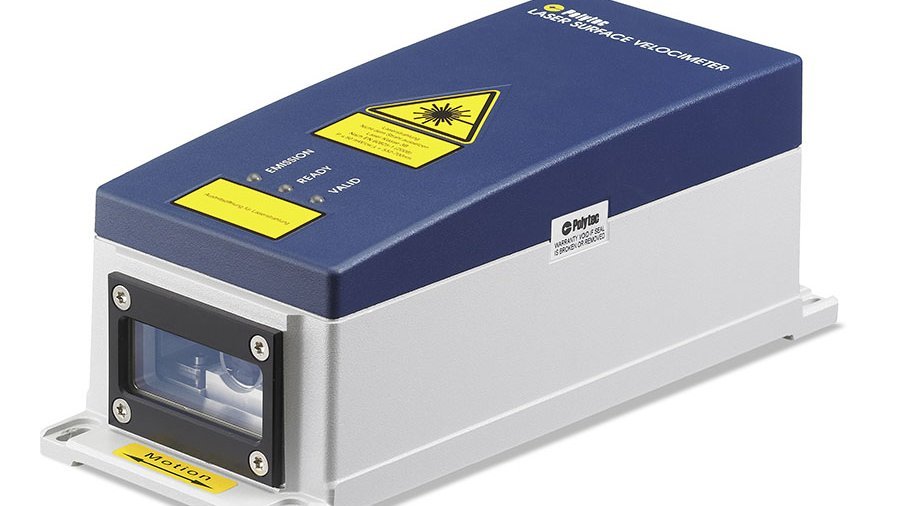In today’s competitive environment the production processes in the aluminium industry have to be optimized to ensure shortest throughput times, highest output and maximum profitability. This can be achieved in no small part by improving process control through the implementation of state-of-the-art measurement equipment. Polytec laser surface velocimeters (LSV) measure length and speed in rolling mills with laser precision.
Mass flow automatic gauge control
Mass flow automatic gauge control (AGC) is a technique used for many years to control strip thickness in rolling mills. It enables tighter control of thickness by providing faster and more accurate control of the roll gap. The mass flow principle states that the strip thickness and speed entering the mill stand must equal the strip thickness and speed exiting the stand, while the width remains constant. Due to the high strip speeds common in aluminium rolling processes the rolling gap needs to be adjusted very fast based on the strip speed and thickness at the entry and exit of the roll stand. Therefore these parameters need to be measured very accurately and with a fast response time.
The thickness of the strip is measured by so called C-Frames using non contact optical or radiometric principles.
Polytec LSV installed directly in the C-Frames or in rugged thermo-protective housings at the entrance and exit of the mill stands measure the speed. They have proven to track strip speed more accurately than contact methods because the LSV is not susceptible to slippage during mill speed transitions.
The improved speed measurement is most noticeable at the beginning and end of the strip and during those periods of mill acceleration and deceleration, where significant errors can occur due to slippage of traditional contact methods. Using Polytec LSV instead allows to control the roll gap much more accurately and therefore to achieve thickness specifications over a greater percentage of the strip. The result is improved quality and increased operational yield.
Cut-to-length control and improved cutting process
When cutting aluminium sheets or plates according to customer requirements precise length and speed measurement is essential. Cutting to short means not meeting the specified minimum length, which is unacceptable for the customer. Cutting too long means that excess material is supplied beyond the specified minimum length. As customers usually pay only for the specified minimum length any excess is given away for free. The precision of the length measurement therefore directly affects the profitability of the production. Using the length measurement of the LSV the cut length is controlled to be as close as possible to the required length.
Furthermore, the length and speed measurement of the LSV is used for controlling the cutting process itself. To optimize throughput during the cutting process the strip movement needs to be stopped very fast at exactly the right position for the cut and then restarted again equally fast. At this point contact based measurement methods are reaching their physical limits. Due to mechanical inertia they cannot follow extremely fast deceleration and acceleration processes. As a result the contact sensor slips on the surface it is measuring on.This leads to incorrect length and speed readings.
In case of a flying cut-off the cutting device needs to move with the strip to ensure a straight, clean cut. As the strip approaches the specified length, the cutting device accelerates to match the speed of the strip and performs the cut. After the cut the cutting device returns to its original home position while in preparation for the next cut.
Speed synchronization on roller beds
The LSV provides length and speed values to not only activate the shear at the appropriate length but also to synchronize its motion to match the speed of the strip.
Aluminium sheets are moving on rollerbeds between different process steps. In this situation it is very important to synchronize the rotational speed of the motorized rollers as accurately as possible with the line speed of the aluminium sheets. On first glance one might think, that the rollers on which the sheets are moving determine their speed. This is, however, not true. Due to the tremendous forces that are applied during rolling, it is in fact the rolling process that determines the speed of the sheets.
If the motorized rollers of the roller bed are not synchronized correctly with the speed of the sheets, this leads to abrasion of the aluminium surface as slippage occurs between the rollers and sheets. Further, the abrasion can form deposits on the rollers and nearby machinery and cause damage to the rollers. Therefore it is necessary to measure the speed of the aluminium sheets with a LSV and adjust the roller speed accordingly.
This specialist article was published in the International ALUMINIUM Journal 11/2019.
